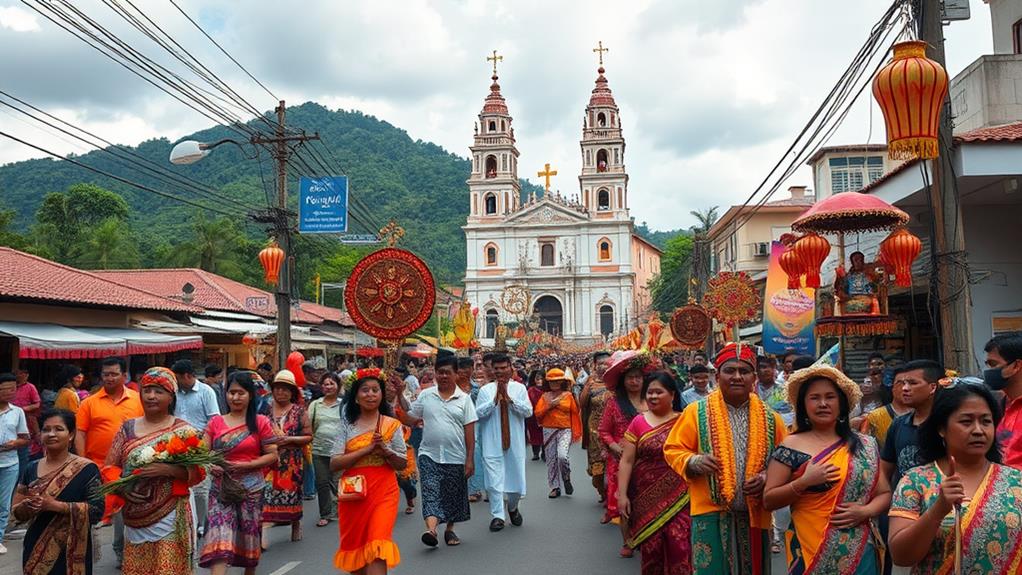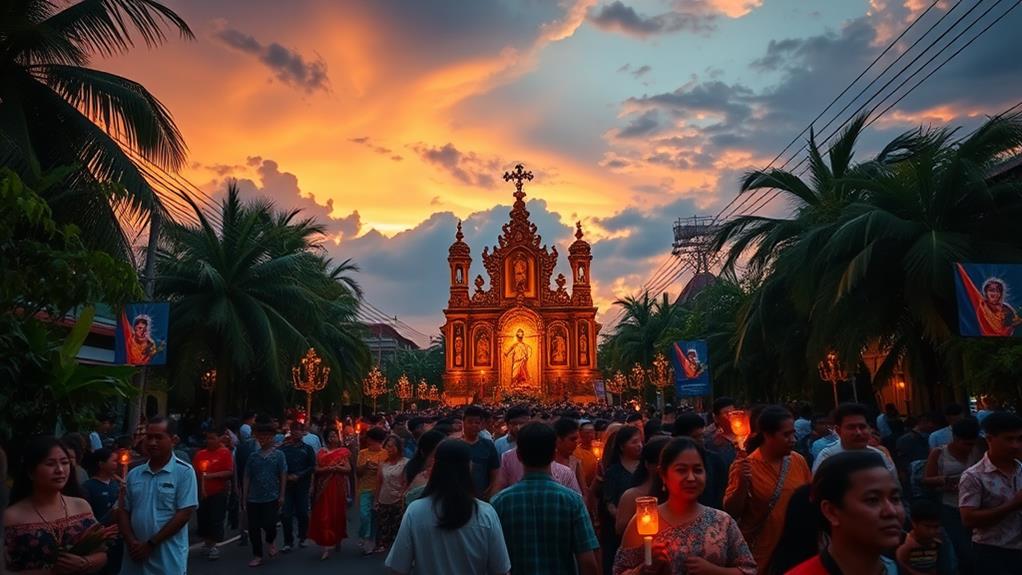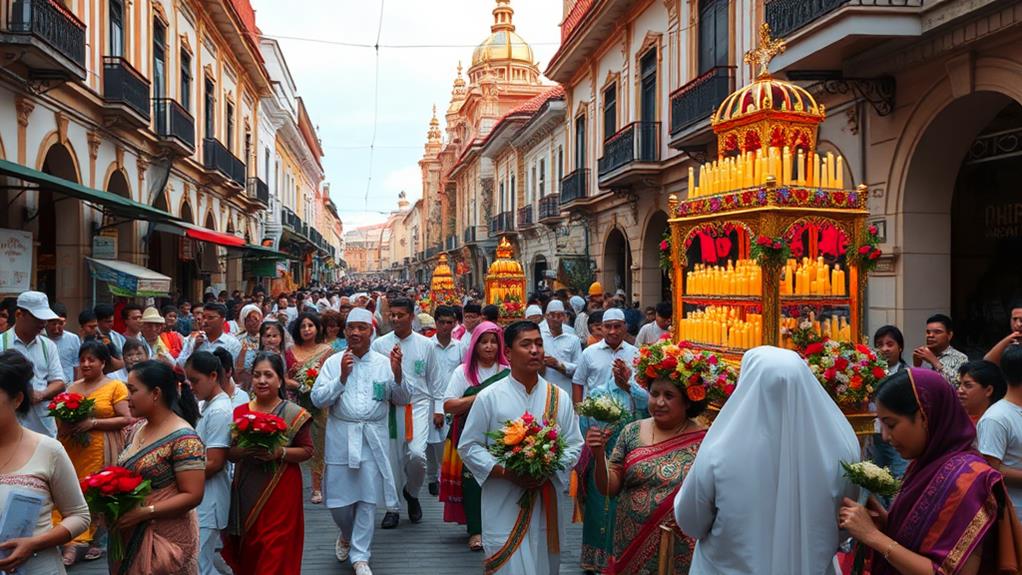During Holy Week in the Philippines, a rich blend of rituals and reflections unite community and faith.
Palm Sunday marks the beginning, where Filipinos bring palm fronds to symbolize protection and commemorate Jesus' triumphant entry into Jerusalem.
On Maundy Thursday, Filipinos attend the Mass of the Lord's Supper, which reenacts Jesus' Last Supper with his disciples.
Visita Iglesia, or visiting seven churches, is another popular tradition, where devotees pray and reflect on the Stations of the Cross.
Good Friday is a day of deep contemplation, as Filipinos participate in the Stations of the Cross, a 14-step devotion that recreates Jesus' journey to Calvary.
Black Saturday is a day of quiet reflection, preparing for the Salubong, a joyous Easter Sunday celebration where Filipinos welcome the risen Christ.
Each ritual echoes emotions and shared experiences, shaping the spiritual journey of Filipinos and revealing the heart of their culture.
Overview of Holy Week Traditions

Holy Week in the Philippines: A Deeply Rooted Tradition
Holy Week in the Philippines is a significant event that brings communities together in reflection and reverence.
Palm Sunday marks the beginning of Holy Week, where locals bring palm fronds to church, symbolizing the welcoming of Jesus into Gethsemane. This ritual not only signifies faith but also serves as a protective charm against evil spirits, blending spirituality and cultural heritage.
Maundy Thursday: A Solemn Reminder
Maundy Thursday is marked by the solemnity of the Mass of the Lord's Supper, a powerful reminder of the Last Supper.
The Alay Lakad pilgrimage to Antipolo Cathedral invites individuals to participate in physical and spiritual journeys of penance.
Good Friday: A Day of Contemplation
Good Friday is marked by a profound stillness, with Stations of the Cross and the Seven Last Words reflections, urging individuals to contemplate Jesus' suffering.
Black Saturday and Easter Vigil: Renewal and Hope
On Black Saturday, the atmosphere shifts into mourning, leading to the Easter Vigil.
The lighting of the Paschal candle symbolizes renewal and hope, as the darkness of mourning gives way to the promise of new beginnings.
Easter Sunday: Joy and Celebration
Easter Sunday erupts in joy with Salubong ceremonies, where the resurrected Christ meets the Virgin Mary, encapsulating the essence of resurrection and the promise of new beginnings.
Cultural Practices and Beliefs
Cultural Practices and Beliefs Shape Holy Week in the Philippines
During Holy Week, Filipinos observe a unique blend of solemnity and community spirit, reflecting the country's rich cultural heritage.
Black Saturday is a significant day of reflection, particularly for young boys who undergo circumcision, marking their transition into manhood.
Folk beliefs and traditions also abound during this period. Jumping before the church bells toll on Easter Sunday is believed to promote height and vitality.
However, since the 1970s, there's been a decline in the solemn observance of Black Saturday, indicating a cultural shift towards modernization.
The Philippines' 85% Christian population contributes to the complex atmosphere during Holy Week, where solemn rituals coexist with festive activities.
Cultural admonitions against laughter emphasize the importance of reflection.
However, as society evolves, some Filipinos reinterpret these traditions, allowing for moments of joy and kindness.
These cultural practices and beliefs not only shape the observance of Holy Week but also highlight the dynamic nature of Philippine spirituality and community life.
Key Religious Observances

Holy Week in the Philippines: A Celebration of Faith and Tradition
Holy Week in the Philippines is a vibrant display of religious observances that showcases the country's deep-rooted commitment to faith and tradition.
Palm Sunday
Palm Sunday marks the beginning of Holy Week. On this day, Filipinos bring palm fronds to church, symbolizing Jesus' entrance into Jerusalem and offering protection against evil spirits.
Maundy Thursday
Maundy Thursday is a significant day in Holy Week. It is commemorated with the Mass of the Lord's Supper, which remembers the Last Supper. Additionally, Filipinos participate in Visita Iglesia, visiting seven churches to reflect on the Stations of the Cross.
Good Friday
Good Friday is a solemn day filled with rituals. Filipinos attend the Stations of the Cross and venerate the Holy Cross. The day culminates in the poignant Santo Entierro procession.
Black Saturday
Black Saturday is a day of mourning. Filipinos hold a vigil that lights the Paschal candle, symbolizing hope and anticipation of resurrection.
Easter Sunday
Easter Sunday is a joyous celebration. Filipinos participate in the Salubong ceremony, where men and women's processions converge, commemorating the triumphant reunion of Jesus and Mary.
Each observance strengthens the connection to faith, community, and shared history.
Modern Interpretations of Faith
Holy Week in the Philippines: A Blend of Tradition and Modernity
During Holy Week in the Philippines, faith is redefined as a dynamic blend of tradition and contemporary issues. Many believers focus on compassion and social justice, aligning with Pope Francis's progressive views on Christianity. The Catholic Church encourages this shift, promoting the expression of love and joy alongside solemn observances.
The Tension between Commercialism and Tradition
However, commercialism threatens to overshadow the religious significance of Holy Week, tempting people with leisure activities like beach trips. This raises questions about the traditional practices of fasting and abstinence, especially when economic realities challenge their feasibility.
These reflections prompt meaningful discussions about the true meaning of these rituals.
Diverse Expressions of Faith
Personal anecdotes from communities reveal that diverse expressions of faith, such as communal gatherings or individual contemplations, can foster a strong sense of connection and spirituality. For instance, some people participate in community service projects, while others engage in personal prayer and reflection.
A More Inclusive Understanding of Holy Week
Ultimately, these modern interpretations of faith encourage a more inclusive understanding of Holy Week, making it a time not just for reflection but also for active engagement with the issues that define our lives today.
This approach promotes a deeper connection with one's faith and community.
How is the devotion to the Santo Niño connected to the rituals of Holy Week in the Philippines?
The santo niño devotion is deeply connected to the rituals of Holy Week in the Philippines. Devotees celebrate the Santo Niño’s blessings throughout the Lenten season and reenact the passion of Christ during Holy Week. The Santo Niño devotion is a central part of the country’s religious and cultural traditions.
Unique Local Celebrations

Holy Week in the Philippines is a vibrant display of local celebrations that reflect deep-rooted traditions and community spirit.
Each event carries profound meaning, inviting you to witness the collective expressions of faith.
The Senakulo, a dramatic reenactment of Christ's Passion, takes place in Bulacan, Rizal, and Pampanga on Maundy Thursday. This captivating event unfolds through dramatic performances, showcasing the community's devotion to their faith.
Visita Iglesia is a tradition where devotees visit seven churches, reflecting on the Stations of the Cross. Some even extend their pilgrimage to 14 churches, demonstrating deeper devotion to their faith.
In Pabasa ng Pasyon, community members gather at makeshift altars to rhythmically chant Christ's sufferings. This unique tradition echoes the community's reverence for their faith.
The Moriones Festival in Marinduque is a colorful reenactment of Christ's final moments. Actors don morion helmets, embodying Roman soldiers, and perform in a dazzling display of community spirit.
On Easter Sunday, the poignant Salubong ceremony takes place. This ceremony marks the joyful meeting of the resurrected Christ and the grieving Virgin Mary, celebrated through distinct processions that highlight the triumph of life over sorrow.
These celebrations not only preserve cultural heritage but also bind communities together, allowing you to connect deeply with the essence of Holy Week.
Personal Reflections and Experiences
Holy Week: A Tapestry of Memories and Rituals
Reflecting on your own experiences during Holy Week can evoke a rich collection of memories, woven together by family traditions and personal rituals.
Palm Sunday: A Symbol of Protection and Spiritual Connection
On Palm Sunday, you may have brought home blessed palm fronds, feeling their significance as a symbol of protection and spiritual connection. This act wasn't just about tradition; it was a moment shared with your family, reinforcing bonds while honoring your faith.
Family Rituals: Blending Reflection and Joy
As the week unfolded, you engaged in family rituals that blended reflection and joy. For example, the Pabasa ng Pasyon, a traditional Filipino chant, resonated with you as the community recounted stories of devotion and forgiveness, deepening your understanding of Christ's passion.
Each verse sung wasn't merely a recitation; it was an emotional journey that connected you with generations before.
Visita Iglesia: A Journey of Introspection
Visita Iglesia, a tradition of visiting multiple churches, may have offered you a unique opportunity for introspection. Each visit held a quiet power, enhancing your spiritual journey and sense of community.
Through these personal reflections, you recognize that Holy Week isn't just a sacred time; it's a mosaic of experiences, where family and faith intertwine, creating lasting impressions on your heart.
Questions and Answers
What Is the Reflection of the Holy Week?
The Reflection of Holy Week: A Time for Spiritual Introspection
During Holy Week, rituals and ceremonies facilitate personal reflection and introspection, allowing individuals to examine their faith and values. This journey is amplified when shared with others, creating a sense of community and collective devotion.
Community Involvement Strengthens Spiritual Connection
Participating in community events, such as the Pabasa ng Pasyon (a traditional chanting of the Passion of Christ) and solemn processions, brings people together in a shared experience of reflection and devotion.
These communal activities encourage individuals to contemplate sacrifice and redemption, fostering a deeper understanding of their faith.
Deepening Faith and Connection
This sacred time encourages individuals to deepen their faith by connecting with others who share similar beliefs and experiences.
As a result, a rich tapestry of shared values and experiences is created, strengthening the bonds between individuals and their community.
How Is Holy Week Celebrated in the Philippines?
In the Philippines, Holy Week is a significant religious celebration that commemorates the passion, death, and resurrection of Jesus Christ.
During this week, vibrant processions take place in towns, reenacting key events in Christ's journey to the cross. These processions often feature life-sized floats and costumed participants who bring the biblical stories to life.
Traditional foods are an integral part of the celebration. Bibingka, a rice cake topped with eggs, cheese, and coconut, and puto bumbong, a purple yam cake, are shared among families and friends as a symbol of unity and community.
Visiting churches is another important custom during Holy Week. Filipinos participate in community prayers and immerse themselves in the solemn atmosphere, reflecting on their faith and the significance of the season.
This spiritual reflection strengthens bonds within the community and deepens one's connection to their heritage.
What Not to Do During Holy Week in the Philippines?
Respect Local Traditions
During Holy Week in the Philippines, avoid loud celebrations or parties, as they disregard cultural customs.
This is a time for solemn reflection and spiritual growth.
Observe Fasting Practices
Abstain from meat on Good Friday, as it's a common practice among Filipinos.
This act of self-denial helps to commemorate the sacrifices of Jesus Christ.
Heed Local Superstitions
Refrain from making business deals, as locals believe it may invite bad luck.
It's essential to be mindful of these superstitions to avoid unintended consequences.
Participate in Solemn Rituals
Attend Mass and engage in other solemn rituals to deepen your connection to this significant period.
What Are the 3 Most Important Days During Holy Week?
The three most significant days during Holy Week are Maundy Thursday, Good Friday, and Easter Sunday.
Maundy Thursday is a day of reflection, where Christians commemorate the Last Supper and the blessing of oils.
This day marks Jesus' last meal with his disciples before he was betrayed, and it's a time to think about the significance of his sacrifice.
Good Friday is a day of solemnity, where Christians contemplate Christ's suffering through the Stations of the Cross.
This day marks the crucifixion of Jesus, and it's a time to reflect on the sacrifice he made for humanity.
Easter Sunday is a day of celebration, where Christians rejoice in the resurrection of Jesus Christ.
This day marks the end of mourning and the beginning of a new life, symbolizing renewal and hope.